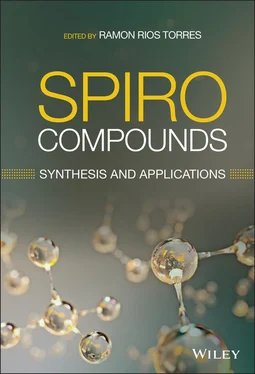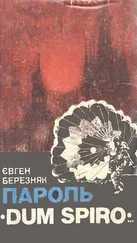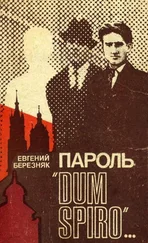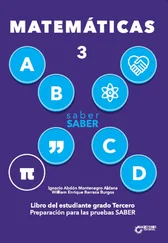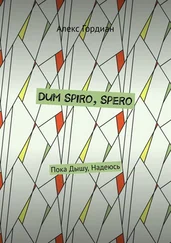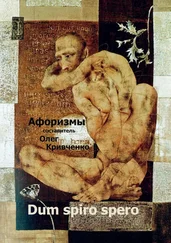Spiro Compounds
Здесь есть возможность читать онлайн «Spiro Compounds» — ознакомительный отрывок электронной книги совершенно бесплатно, а после прочтения отрывка купить полную версию. В некоторых случаях можно слушать аудио, скачать через торрент в формате fb2 и присутствует краткое содержание. Жанр: unrecognised, на английском языке. Описание произведения, (предисловие) а так же отзывы посетителей доступны на портале библиотеки ЛибКат.
- Название:Spiro Compounds
- Автор:
- Жанр:
- Год:неизвестен
- ISBN:нет данных
- Рейтинг книги:3 / 5. Голосов: 1
-
Избранное:Добавить в избранное
- Отзывы:
-
Ваша оценка:
- 60
- 1
- 2
- 3
- 4
- 5
Spiro Compounds: краткое содержание, описание и аннотация
Предлагаем к чтению аннотацию, описание, краткое содержание или предисловие (зависит от того, что написал сам автор книги «Spiro Compounds»). Если вы не нашли необходимую информацию о книге — напишите в комментариях, мы постараемся отыскать её.
A comprehensive treatment of the latest research in, and applications of, spiro compounds Spiro Compounds: Synthesis and Applications
Spiro Compounds
Spiro Compounds — читать онлайн ознакомительный отрывок
Ниже представлен текст книги, разбитый по страницам. Система сохранения места последней прочитанной страницы, позволяет с удобством читать онлайн бесплатно книгу «Spiro Compounds», без необходимости каждый раз заново искать на чём Вы остановились. Поставьте закладку, и сможете в любой момент перейти на страницу, на которой закончили чтение.
Интервал:
Закладка:
407 406
408 407
409 408
410 409
411 410
412 411
413 412
414 413
415 414
416 415
417 416
418 417
419 418
420 419
421 420
422 421
423 422
424 423
425 424
426 425
427 426
428 427
429 428
430 429
431 430
432 431
433 432
434 433
435 434
436 435
437 436
438 437
439 438
440 439
441 440
442 441
443 442
444 443
445 444
446 445
Spiro Compounds
Synthesis and Applications
Edited by
Ramon Rios Torres
University of Southampton
Southampton, United Kingdom

This edition first published 2022
© 2022 John Wiley & Sons, Inc.
All rights reserved. No part of this publication may be reproduced, stored in a retrieval system, or transmitted, in any form or by any means, electronic, mechanical, photocopying, recording or otherwise, except as permitted by law. Advice on how to obtain permission to reuse material from this title is available at http://www.wiley.com/go/permissions.
The right of Ramon Rios Torres to be identified as the author of the editorial material in this work has been asserted in accordance with law.
Registered Office John Wiley & Sons, Inc., 111 River Street, Hoboken, NJ 07030, USA
Editorial Office 111 River Street, Hoboken, NJ 07030, USA
For details of our global editorial offices, customer services, and more information about Wiley products visit us at www.wiley.com.
Wiley also publishes its books in a variety of electronic formats and by print-on-demand. Some content that appears in standard print versions of this book may not be available in other formats.
Limit of Liability/Disclaimer of Warranty
In view of ongoing research, equipment modifications, changes in governmental regulations, and the constant flow of information relating to the use of experimental reagents, equipment, and devices, the reader is urged to review and evaluate the information provided in the package insert or instructions for each chemical, piece of equipment, reagent, or device for, among other things, any changes in the instructions or indication of usage and for added warnings and precautions. While the publisher and authors have used their best efforts in preparing this work, they make no representations or warranties with respect to the accuracy or completeness of the contents of this work and specifically disclaim all warranties, including without limitation any implied warranties of merchantability or fitness for a particular purpose. No warranty may be created or extended by sales representatives, written sales materials or promotional statements for this work. The fact that an organization, website, or product is referred to in this work as a citation and/or potential source of further information does not mean that the publisher and authors endorse the information or services the organization, website, or product may provide or recommendations it may make. This work is sold with the understanding that the publisher is not engaged in rendering professional services. The advice and strategies contained herein may not be suitable for your situation. You should consult with a specialist where appropriate. Further, readers should be aware that websites listed in this work may have changed or disappeared between when this work was written and when it is read. Neither the publisher nor authors shall be liable for any loss of profit or any other commercial damages, including but not limited to special, incidental, consequential, or other damages.
Library of Congress Cataloging-in-Publication Data
Names: Riós Torres, Ramón, author.
Title: Spiro compounds : synthesis and applications / Ramon Rios Torres, University of Southampton, Southhampton, United Kingdom.
Description: First edition. | Hoboken, NJ : Wiley, 2022. | Includes index.
Identifiers: LCCN 2021031988 (print) | LCCN 2021031989 (ebook) | ISBN 9781119567639 (hardback) | ISBN 9781119567622 (adobe pdf) | ISBN 9781119567653 (epub)
Subjects: LCSH: Organic compounds–Structure.
Classification: LCC QD255.4 .R56 2022 (print) | LCC QD255.4 (ebook) | DDC 547/.5–dc23
LC record available at https://lccn.loc.gov/2021031988LC ebook record available at https://lccn.loc.gov/2021031989
Cover Design: Wiley
Cover Image: © Connect world/Shutterstock
List of Contributors
Vikas R. AswarDepartment of Chemistry, Indian Institute of Technology Bombay, Mumbai, India
Lu BaiKey Laboratory of Synthetic and Natural Functional Molecule of the Ministry of Education, College of Chemistry & Materials Science, Northwest University, Xi’an, China
Matthias BaudSchool of Chemistry and Institute for Life Sciences, University of Southampton, Southampton, UK
Hak‐Fun ChowDepartment of Chemistry, Institute of Molecular Functional Materials and The Center of Novel Functional Molecules, The Chinese University of Hong Kong, Shatin, Hong Kong
Xavier CompanyóDepartment of Chemical Sciences, University of Padova, Padova, PD, Italy
Xiao‐Yuan CuiSchool of Chemistry and Molecular Engineering, East China Normal University, Shanghai, China
Luca Dell’AmicoDepartment of Chemical Sciences, University of Padova, Padova, PD, Italy
Sambasivarao KothaDepartment of Chemistry, Indian Institute of Technology Bombay, Mumbai, India
Dietmar KuckDepartment of Chemistry and Center for Molecular Materials (CM2), Bielefeld University, Bielefeld, Germany
Jingjing LiuKey Laboratory of Synthetic and Natural Functional Molecule of the Ministry of Education, College of Chemistry & Materials Science, Northwest University, Xi’an, China
Xinjun LuanKey Laboratory of Synthetic and Natural Functional Molecule of the Ministry of Education, College of Chemistry & Materials Science, Northwest University, Xi’an, China
Marta MeazzaSchool of Chemistry, University of Southampton, Southampton, UK
Albert MoyanoSecció de Química Orgànica, Departament de Química Inorgànica i Orgànica, Facultat de Química, Universitat de Barcelona, Barcelona, Catalonia, Spain
Suva PariaDepartment of Chemical Sciences, University of Padova, Padova, PD, Italy
Ramon RiosDepartment of Organic Chemistry, University of Southampton, Southampton, UK
Yellaiah TangellaDepartment of Chemistry, Indian Institute of Technology Bombay, Mumbai, India
Alberto Vega‐PeñalozaDepartment of Chemical Sciences, University of Padova, Padova, PD, Italy
Jan VeselýDepartment of Organic Chemistry, Faculty of Science, Charles University, Prague, Czech Republic
Michal UrbanDepartment of Organic Chemistry, Faculty of Science, Charles University, Prague, Czech Republic
Peng‐Wei XuSchool of Chemistry and Molecular Engineering, East China Normal University, Shanghai, China
Jin‐Sheng YuSchool of Chemistry and Molecular Engineering, East China Normal University, Shanghai, China
Jian ZhouSchool of Chemistry and Molecular Engineering, East China Normal University, Shanghai, China
Preface
When I was a kid, I dreamt to be an engineer and build planes, cars, etc. However, in high school, I felt in love with Organic Chemistry. I changed my dreams of building things for how to assemble C, H, N, and other atoms to form molecules. I was always astonished of the inherent difficulty of organicstructures, not only for their diversity and ordered assembly but also for their 3D shape. With time, I enjoyed learning Organic Chemistry: starting from my bachelor in organic chemistry, followed by a PhD in organometallic chemistry, and several postdocs in organometallic chemistry and organocatalysis. Later on, as academic, I have always tried to develop new reactions that can allow to obtain difficult structures in an enantiopure form. However, one of the greatest challenges that I faced has been the synthesis of spiro compounds. My own way to be interested in the synthesis of spiro compounds first started in the synthesis of quaternary carbons in an enantiopure fashion. Precisely, while studying how to synthesize quaternary carbons, I developed an interest in spiro compounds, how difficult it will be to join two cycles by a single atom, and do it enantioselectively. In my research group, we have been lucky enough to develop several reactions that led to spiro compounds in an enantiopure form (or almost enantiopure), but I still remember the first time that we got a spiro compound in an enantiopure form as an incredible feeling of achievement. Now, several years later, I decided to honor this type of compounds by editing a book, summarizing the achievements that Organic Chemists have been done in the last decades.
Читать дальшеИнтервал:
Закладка:
Похожие книги на «Spiro Compounds»
Представляем Вашему вниманию похожие книги на «Spiro Compounds» списком для выбора. Мы отобрали схожую по названию и смыслу литературу в надежде предоставить читателям больше вариантов отыскать новые, интересные, ещё непрочитанные произведения.
Обсуждение, отзывы о книге «Spiro Compounds» и просто собственные мнения читателей. Оставьте ваши комментарии, напишите, что Вы думаете о произведении, его смысле или главных героях. Укажите что конкретно понравилось, а что нет, и почему Вы так считаете.
